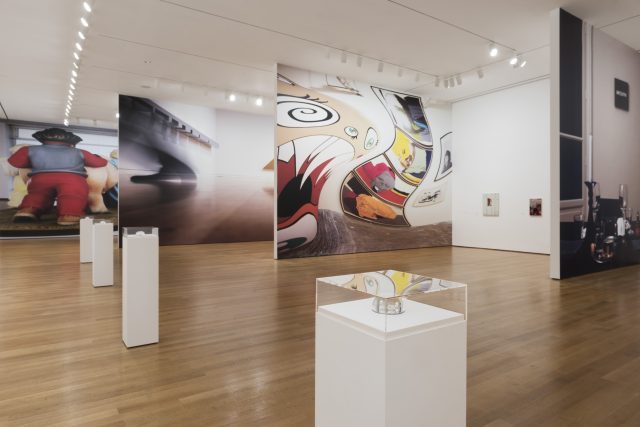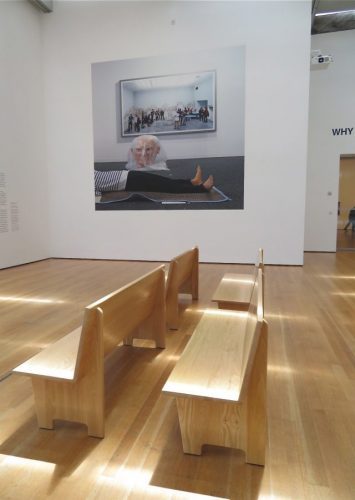
“Louise Lawler: WHY PICTURES NOW” features paperweights, distorted images, and other works that examine truth in unique ways (© 2017 The Museum of Modern Art; photo by Martin Seck)
MoMA, Museum of Modern Art
11 West 53rd St. between Fifth & Sixth Aves.
Through July 30, $25
212-708-9400
www.moma.org
Right outside “Louise Lawler: WHY PICTURES NOW” on MoMA’s sixth floor are several benches that seem ideally placed for tired museumgoers ready to take a break before entering the exhibition. Curiously, however, the benches do not face the introductory text, the entrance, or the barely visible projections of various phrases on a wall. And if you do sit on one of the benches, a security guard will immediately tell you to get up, because it is actually part of the show, a collaboration between Lawler and Cameron Rowland called “New York State Unified Court System.” (The legal reference relates to Lawler’s widespread use of appropriation.) It’s a genius way to begin the exhibition, the first major New York museum survey of Lawler’s work, which for forty-five years has focused on how art is presented to and experienced by the viewer. Born in Bronxville in 1947, Lawler is best known for her photographs of paintings and sculptures by other artists, as the works are in the process of being hung or taken down in museums or seen in collectors’ homes and auction houses, often with sly twists. In an untitled 1950–51 silver dye bleach print, an empty bench sits in front of a Joan Miró canvas that is mostly out of the frame of the photo. In “Monogram,” Jasper Johns’s “White Flag” is on the wall behind a bed covered by a monogrammed sheet. In “White Gloves,” an art handler wearing white gloves is carefully unwrapping a portrait by Gerhard Richter, which is staring right back at the viewer. In her paperweights series, such photos as “Reception Area” and “Untitled (Flavin)” are difficult to see (unless you’re rather tall), placed as they are in small paperweights on individual stands. For her “Adjusted to Fit” series, Lawler takes pictures of others’ artworks, then creates large-scale distorted adhesive vinyl prints that she stretches out to fit on gallery walls; in “Big,” Maurizio Cattelan’s “Picasso — Puppet” is being unpacked, the body of the sculpture lying on the floor, the giant head behind it still in plastic, and behind that is Thomas Struth’s “Pergamon Museum IV, Berlin,” a photograph of people milling about a display of Greek friezes and a headless statue. Thus, Lawler challenges the viewer to get their mind around a series of gazes in which they appear to be both subject and object.

Don’t get too comfortable on benches at entrance to “Louise Lawler: WHY PICTURES NOW” (photo by twi-ny/mdr)
For her “Tracings” series, Lawler, who was part of the Pictures Generation with Cindy Sherman, Robert Longo, Barbara Kruger, David Salle, Laurie Simmons, Richard Prince, and others, creates black-and-white drawings of some of her photographs, including “Pollyanna” and “Triangle,” on adhesive vinyl, removing the color and details, leaving behind a large-format blueprint that looks like it was drawn right on the wall. Of particular interest is “Salon Hodler,” which appears in the show as a regular photograph, inside a paperweight, as a digital gif, and as a tracing. There are numerous chairs in this part of the gallery, where visitors are encouraged to sit and study any of the tracings, yet another wry comment from Lawler, giving museumgoers the opportunity to take their time with works that lack the kind of content evident in the other rooms. The show also features postcards, printed matchbooks, announcement cards, envelopes, press releases, and other items Lawler made for various gallery shows, in addition to collaborations with Lawrence Weiner, Sherrie Levine, Allan McCollum, Felix Gonzalez-Torres, and Andrea Fraser. Finally, out in the Abby Aldrich Sculpture Garden is “Birdcalls,” a seven-minute sound installation recorded and mixed by Terry Wilson in which Lawler chirps and peeps the names of twenty-eight well-known male artists, from Vito Acconci and John Baldessari to Dan Graham and Donald Judd, from Anselm Kiefer and Sol LeWitt to Julian Schnabel and Cy Twombly, not a single woman in the bunch, noting the inherent, primary white male privilege of the international art world. It’s also important to point out that the title of the exhibit, “WHY PICTURES NOW,” purposely does not have a question mark, instead making a firm statement. To cap it all off, Lawler provides us with one last message that we can literally bring home with us: If the artwork on the exhibition poster doesn’t look familiar, that’s because it’s actually not part of the show.